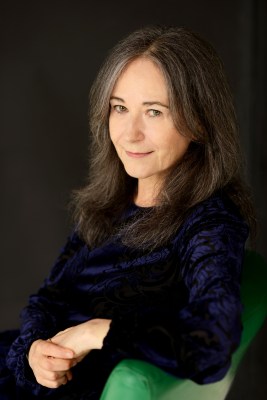Q&A With Elise Levine, Author of “Big of You”

Though the settings of the stories in Elise Levine’s most recent book, Big of You, range from 19th century Paris to a distant future in outer space, the emotional locus hits close to home. Anyone who has ever felt doubt or regret or hope for a better future (aka all of us) will relate to the themes in the nine stories in Levine’s sixth book. In “Penetrating Wind Over Open Lake,” the speaker is an ambitious grad student in a prestigious music program. “I pushed on,” she says. “Made time. Toward the dream of a place in the world for who I wanted to be. A someone, a somebody.” Indeed, the entire collection seems to ask, what does it mean to be “somebody”? And how do we figure out just who our “somebody” is?
With the lyrical, intimate, and at times irreverent voice that readers may recognize from her earlier works, Levine introduces characters who are nostalgic for pasts they don’t quite understand as they reckon with present moments that don’t quite live up to their youthful expectations. As these protagonists try to find ways of living in the realities they have wrought, they wrestle with questions about success and connection. How can one be a good employee, a good son or daughter, a good friend, a good partner? What pieces of the past should we hold onto – and which should we let go?
Levine’s stories examine the misconceptions that go along with being young, giving voice to that sense so many of us have as we look back on our teens and early twenties. The speaker in the opening story, “Arnhem,” asks, “What’s my point with any of this? What was even the point of us. We who believed we could make ourselves into who we wanted, and that life would bless us in complicated, interesting ways.”
As readers of Levine, we are indeed blessed with a complicated and interesting voice who renders searing scenes of connection and disconnection with acute attention to the nuances of human emotion and a poet’s musical ear. Read on to learn more about her most recent work, and find details about her upcoming book events.

Baltimore Fishbowl: The last time we spoke about your work was in 2022 when your pair of novellas, Say This, came out. Back then you noted that one of the novellas had started as a story but just grew into a longer form. How do you know when a story is really a story? And what is your process for putting together a collection of shorter fiction? Did you have certain pieces that came first and then others you wrote with a cohesive collection in mind? Did you write any of these stories specifically for the collection?
Elise Levine: More typically, my initial idea for a character and setting and basic situation—which arrive out of the blue and bundled together—also arrives with a notion of the degree of development or compression. I’ll know off the bat that a narrative will unfold over a novel or longer short story, or through the sharp burst of a shorter story or flash fiction.
Big of You came together in an unusual way. I was working on the novellas in Say This and entertaining ideas for new short stories that might sit together. Once I had the head space to focus on them, “Arnhem”—which became the first story in the collection—announced itself unexpectedly, and I wrote it quickly. From there, over the course of a week, I dropped some of my original ideas, kept others, and introduced new ones, mapping out what became Big of You: nine stories, with the titles and order in which they’d appear, and with ideas for how I might braid them together. I then worked on the stories in that order.
BFB: Some of your characters appear in more than one story. For example, the nameless friend and her brother in “Arnhem” reappear in “Dig”. The missing fourth friend in “Return to Forever” reappears in “Take Ten”. Did you plan for some of the stories to connect in this way? What do you think the collection gains (and I love these subtle links) by having some of the stories intertwined?
EL: Yes, I did plan from the outset for those characters to reappear, as does the composer boyfriend in “Penetrating Wind Over Open Lake”, who becomes the narrator of the later story “Sounds Like”. Intertwining the stories meant I could develop these characters over time, in different circumstances and from varied perspectives, adding greater dimension to their self-recognitions and self-deceits.
BFB: I noticed that many of the stories feature characters who find themselves disappointed – or at least underwhelmed – by where their careers have taken them. What interests you about the theme of ambition and professional success? Has your own definition of success changed over time?
EL: One of my interests in Big of You is how our ambitions and striving can open us to exploitation and its psychically parlous effects. Through the stories I asked myself: How and why does this happen? What efforts and circumstances might it take to break the cycle? Each story leaves the questions largely unresolved, but etched, I hope, into sharper relief and with a heightened urgency. I wrote Big of You in a state of marveling at the nine lives (at least) that I’ve had so far—with a panoply of jobs and creative goals under my belt and having lived half my life so far in Canada and nearly half in the U.S. It struck me that disenchantment can electrify and serve as a generative force. It sears away the selves one has inhabited and which no longer serve.
BFB: Your voice is so distinct in everything you have written. What, if anything, do you think is different about your voice in this collection? Did anything feel different to you as you wrote it?
EL: I think of voice in terms of each story, each character. So “Arnhem” and “Sounds Like” reflect their characters at a particular stage of their lives by using a simpler, more direct syntax and a tamped-down affect. “Dig!” and “Cooler” feature more complex sentences and longer paragraphs, and a swingy, high-to-low range of diction, reflecting a more emotionally volatile registers. For the collection as a whole I sought a protean, propulsive style. And this felt very freeing—to allow myself that expressive breadth in giving voice to characters who test limits, their own and those imposed upon them.
BFB: You’ve lived in Baltimore for quite a while now, but most of the stories seem to take place in other settings – Europe, Michigan, Canada, the desert, even a space station. How do you decide where to set a story and how does place inform the narrative?
EL: No disrespect to Baltimore, which I’m lucky to call home. But from the initial conception of the book, I did see these stories as ranging, not only in terms of language, but also into fabulist and surreal territories to convey a sense of beyondness. Place was key to this project: the settings, with the challenges and opportunities they present the characters, drive the stories toward the potentially unboundaried that the characters experience.
BFB: Could you talk about the title (which I love)? How did you choose it?
EL: Glad you love it! My working title was, to put it politely, infelicitous. Once I’d finalized the collection, I had the sense to tell myself time’s up, you truly need a new title and now. Something to suggest the absurd and domineering forces arrayed against a person, a title that gets at the person told they’re too big for their britches, and also the person who really is self-deluded, self-inflated. A cheeky title, to convey defiance. Weirdly, within minutes Big of Me popped into my head and I thought: got you, there you are.
Launch Events
10/16 at 6pm at Bird in Hand with Dora Malech – in conversation with Nate Brown.
10/21 at 7pm at Lost City Bookstore in DC with Jeannie Vanasco – in conversation with Philip Dean Walker
Click the links above to RSVP for the events.
Related
Source link




